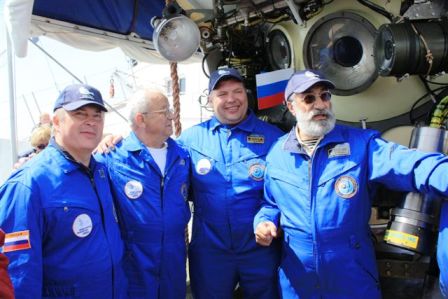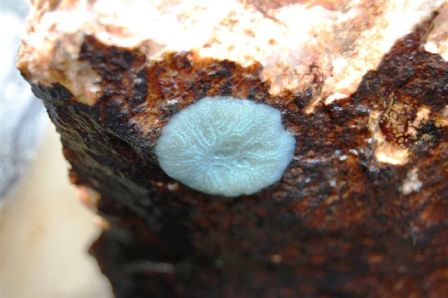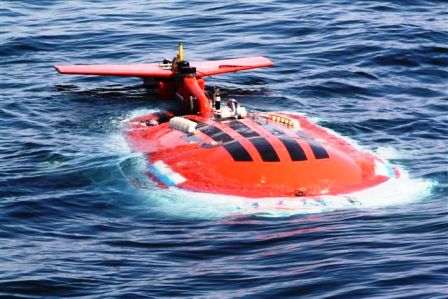July 10, 2008: Start of the Mirs on Baikal International Research Expedition. A Ruslan strategic military transport aircraft delivers the Mir-1 and Mir-2 manned submersibles from Kaliningrad – the homeport of the Akademik Mstislav Keldysh scientific research craft – to Ulan-Ude, from where the craft are transferred to Lake Baikal. This marks the most ambitious shipment of the Mir manned submersibles ever staged.

July 11, 2008: A red
carpet welcome for the Mir-1 and Mir-2 manned submersibles is
staged on Ulan-Ude’s central square. In keeping with the
national tradition of Buryatia, members of the Mirs on Baikal
expedition are presented national white “khadak” scarves – a symbol
of water, purity and good will. The Ulan-Ude presentation
includes welcoming addresses by: Republic of Buryatia President
V. V. Nagovitsyn; the Buryatia People’s Khural
Chairman M. M. Gershevich; Director of the
Baikal Institute of Nature Management of the Siberian Branch of the
Russian Academy of Sciences A. K. Tulokhonov; and
A. M. Sagalevich, Director of the Manned
Submersibles Laboratory of the P. P. Shirshov Institute of
Oceanology of the Russian Academy of Sciences.
July 24, 2008: The first successful
technical submersions of Mir-1 and Mir-2 into Lake Baikal.
The Mir manned submersibles are lowered into the water from the
Metropoliya special-purpose ship. In the future, Metropoliya
will also transport the Mir manned submersibles to their
dislocation points, lowering them into the water and raising them
back onto the craft. The first Mir submersions into Lake
Baikal are conducted at a depth of 420 meters, some six kilometers
from Turka Port.
Piloted by A. M. Sagalevich and E. S.
Chernyayev, the Mir-1 and Mir-2 crews include
representatives of Germany’s Lloyd company.
Lloyd specialists test the Mir-1 and Mir-2 manned submersibles at
various depths and certify the crafts’ instruments, describing the
Mir manned submersibles’ condition as excellent.
According to E. S. Chernyayev, the submersibles’
preparation for the freshwater submersions represents the most
responsible stage the Mir on Baikal expedition’s organization
process. With this in mind, he calls the operational
preparations an enormous success that has fully readied the Mir
submersibles for their first full-scale scientific
expedition. The expedition’s deputy chief A. M.
Sagalevich noted the outstanding organization of the
comprehensive scientific research expedition, expressing his
personal gratitude to M. V. Slipenchuk.
July 29, 2008: The first scientific
submersions of the Mir-1 and Mir-2 manned submersibles are staged
in the deepest portion of Lake Baikal, between Olkhon Island and
the Svyatoi Nos Peninsula.

The Mir-1 manned submersible sets off at 1:30 pm
local time. Its crew includes the President of the Republic
of Buryatia V. V. Nagovitsyn, the Head of
METROPOL Group of Companies M. V. Slipenchuk, and
A. M. Sagalevich, Director of the Manned
Submersibles Laboratory of the P. P. Shirshov Institute of
Oceanology of the Russian Academy of Sciences.
The submersion of the Mir-2 manned submersibles assumes 20 minutes
later. Its crew includes pilot E. S.
Chernyayev, State Duma of the Russian Federation Deputy
V. S. Gruzdev, and A. K.
Tulokhonov, Director of the Baikal Institute of Nature
Management of the Siberian Branch of the Russian Academy of
Sciences.
The Mir-1 manned submersible lowers a 50-centimeter triangular
pyramid to a depth of 1,580 meters. The small object bears
the coats of arms of Russia and Buryatia, as well as an inscription
reading “85th Anniversary of the Republic of Buryatia.” The
Mir-2 manned submersible lowers two titanium flags to the bottom of
the lake – one of the Russian Federation and the other of the
Republic of Buryatia – as well as a small capsule with a message to
future generations from the Fund for Protection of Lake
Baikal.
The Mirs of Baikal scientific research expedition’s Director and
Fund for Protection of Lake Baikal President A. N.
Chilingarov observes the expedition’s progress from the
deck of the Metropoliya special-purpose ship. The Mir-1
manned submersible resurfaces on Lake Baikal at around 7:30 pm and
is raised back onboard the Metropoliya. The Mir-2 manned
submersible reemerges at 9:00 pm. During their mission, the
two craft take soil and water samples, receive data about the
animal and plant kingdoms of Lake Baikal, and pick up new
information about the tectonic processes occurring at the bottom of
the basin.
Upon the submersions’ completion, members of the Mir on Baikal
International Research Expedition stage a press conference onboard
the Metropoliya. It is attended by all the members of the two
Mir crews, as well as the expedition Director A. N.
Chilingarov.
The deputy mission chief A. M. Sagalevich tells
reporters that both Mir manned submersibles were lowered in a spot
that is considered to mark the deepest point of Lake Baikal – a
depth of some 1,637 meters. According to preliminary
instrument readings, however, the depth at the point of the
submersions stood at 1,580 meters. After passing several
miles along the bottom of the lake, the expedition crews are unable
to detect any sudden changes in the depth.
Later, the researchers refine their sensor readings (the Mir manned
submersibles’ sensors are designed to operate in saline
seawater). This readjustment shows that the two Mir craft had
in fact submerged to depths of 1,622 and 1,634 meters,
respectively.
However, it is still premature to discuss any reviews about the
true depths of lake – many more submersions are planned, and the
expedition crews do not exclude the possibility of finding even
lower depths on Lake Baikal.
During the press conference, Head of METROPOL
Group of Companies and Chairman of the Guardianship Board of the
Fund for Protection of Lake Baikal M. V.
Slipenchuk points the journalists’ attention to the fact
that these submersions were not being staged in pursuit of a
record. Rather, they are designed to obtain new data that can
help further the development of Russian science. Expedition
chief A. N. Chilingarov thanks M. V.
Slipenchuk for organizing the scientific research
expedition, especially underscoring the enormous work that is being
done for the overall good of Russia.
Republic of Buryatia President V. V. Nagovitsyn,
who joined the Mir-1 crew, thanks the Fund for Protection of Lake
Baikal’s leadership for granting him the opportunity to conduct
this submersion and to personally ensure that the bottom of the
lake was clean. In confirmation of these words, all seven
members of the expedition take sips of water from a capsule that
they filled at the bottom of Lake Baikal.
August 2, 2008: The Mir manned submersibles
embark on scheduled scientific research submersions some 14 miles
off Olkhon Island. The Mir-1 crew includes the Deputy
Director of the Mirs on Baikal expedition and Chairman of the
Technical Board of the Fund for Protection of Lake Baikal
A. M. Sagalevich, the Director of the P. P.
Shirshov Institute of Oceanology of the Russian Academy of Sciences
and academician R. I. Nigmatulin, and Ulan-Ude
Mayor G. A. Aydayev. The Mir-1 manned
submersible reach a depth of 1,313 meters. It completes a set
of geological studies on the lake’s floor, sampling the region’s
sediment and collecting water samples at various depths.
The Mir-2 crew includes pilot E. S. Chernyayev and
P. P. Shirshov Institute of Oceanology of the Russian Academy of
Sciences Professor B. I. Nigmatulin. The
Mir-2 manned submersible conducts a safety system check on the
craft and tests its new equipment. Both Mir manned
submersibles spend about four hours under water.
August 4, 2008: The Mirs on Baikal
International Scientific Research Expedition stages a Moscow press
conference that is attended by: A. N. Chilingarov,
President of the Fund for Protection of Lake Baikal and expedition
Director; V. A. Grachyov, State Duma of the
Russian Federation Deputy and environmental issues coordinator for
United Russia; V. I. Strugatsky, Vice President of
the Association of Russian Polar Explorers; and the Deputy Dean of
the Geography Faculty of the M. V. Lomonosov Moscow State
University S. A. Dobrolyubov.
The press conference summarizes the results of the first stage of
submersions that the Mir manned submersibles conducted within the
frameworks of the Mir on Baikal International Scientific Research
Exhibition. A. N. Chilingarov reports that
expedition organizers faced a number of complicated technical
challenges involving the Mir manned submersibles’ delivery to Lake
Baikal, organization of the carrier craft’s mode of operation, and
the manned submersibles’ lowering method, among others.
The press conference also includes a direct phone-in presentation
by the Head of the METROPOL Group of Companies and Chairman of the
Guardianship Board of the Fund for Protection of Lake Baikal
M. V. Slipenchuk. He says that organizers
prepared the mission with two specific goals in mind: to pursue the
comprehensive study of Lake Baikal, and to direct state, business
and public officials’ attention to the problems facing the Baikal
region’s population. The region’s residents are living in
poverty despite having every right to use the riches of their
land. But, as M. V. Slipenchuk points
out, this utilization of the Baikal region’s natural resources must
be conducted under careful scientific control.
The press conferences further includes a direct phone-in
presentation by the Director of the P. P. Shirshov Institute of
Oceanology of the Russian Academy of Sciences and Russian Academy
of Sciences member R. I. Nigmatulin, who heaps
warm praise on the expedition’s organization. He also notes
that the most interesting studies on the soil’s geology will be
conducted at upcoming submersions, which are scheduled for the
southern portion of Lake Baikal.
August 4, 2008: The Mir-1 and Mir-2 stage
another successful scheduled scientific research submersion in Lake
Baikal. The Mir manned submersibles’ crew includes several
staff members from the Limnological Institute of the Siberian
Branch of the Russian Academy of Sciences. The submersions
are staged near Maksimikha Bay, which is part of Lake Baikal’s
Barguzin Bay. The Mir-1 and Mir-2 manned submersibles reach a
depth of some 850 meters. The two vessels work about two
kilometers apart. The submersions last for several hours and
include geological studies of the soil. The scientists
discover a new, previously-unknown type of Baikal Planariidae – a
family of small flatworms that inhabit deep waters.
August 6, 2008: During one of their Mir
submersions, staff members from the Limnological Institute of the
Siberian Branch of the Russian Academy of Sciences discover a spot
from which oil flows into the lake’s waters. The oil-flow
location is identified at a depth of 850 meters, just south of the
mouth of Barguzin Bay.
Dr. Mikhail Grachyov, who heads the Limnological
Institute of the Siberian Branch of the Russian Academy of
Sciences, believes that the samples taken during the submersion
could hold the key to the origin’s of the lake’s oil.

August 11, 2008: Several
sponges inhabiting the bottom of Lake Baikal are recovered during
one of the Mir submersions. Later studies confirm that
researchers have discovered a previously-unknown type of Lake
Baikal endemic – a blue sponge.
August 12, 2008: A new round of Mir
submersions include the staff members of the Limnological Institute
of the Siberian Branch of the Russian Academy of Sciences, the
Institute of General and Experimental Biology of the Siberian
Branch of the Russian Academy of Sciences, and the Geology
Institute of the Siberian Branch of the Russian Academy of
Sciences. The submersions are staged at depths ranging
between 40 and 1,580 meters, just south of Cape Ukhan.
August 13, 2008: The Mir manned submersibles
stage a submersion just north of Cape Izhimey. Scientists
take their first-ever samples of representatives of deep-water Lake
Baikal Spongillas. They scientifically classify the
discovered Lake Baikal sponges and take water, rock and silt
samples at depths ranging between 1,213 and 1,553 meters.
These samples later put through a series of microbiological,
mineralogical, chemical and hydrobiological tests.
August 14, 2008: The new round of Mir
submersions includes the writer Valentin Grigoryevich
Rasputin. The Mir-1 manned submersible takes the author to a
depth of 800 meters, also sampling water during its three-hour
mission. V. G. Rasputin shares his first
impressions immediately after returning the surface: “I thought
that I knew Lake Baikal well. It turns that this was not the
case, particularly as far as its underwater world is
concerned. And there is an amazing world down there, one that
has not yet been fully understood or even named – but which is
incredibly rich. You get a sense of order down there, a sense
of special beauty and peace, friendship and – what is most
important – complete absence of anger. Yes, these are lower
forms of life living down there – but in some sense, they are far
above us!” The author calls Mir on Baikal an indispensable
and timely expedition, expressing his desire to become fully
involved in the Fund for Protection of Lake Baikal.
August 15, 2008: The Mir-1 and Mir-2 manned
submersibles stage a new set of submersions near Olkhon
Island. Their crews include staff members from the
Limnological Institute of the Siberian Branch of the Russian
Academy of Sciences and the Baikal Institute of Nature
Management.
August 18, 2008: The scientific team of the
Mirs on Baikal expedition reports the Mir-1 and Mir-2 submersions’
first study results. A total of 26 Lake Baikal submersions
were conducted between July 24 and August 17, which is a kind of
record for this type of expedition work.

August 20, 2008: The
Mir-1 and Mir-2 manned submersibles stage another series of
scheduled submersions near Olkhon Gates Strait. The
submersions also include a foreign observer – the US zoologist
Paul Eisley.
August 22, 2008: The RIA Novosti news agency
hosts a press conference organized by the Fund for Protection of
Lake Baikal and the Green Sail National Public Organization.
The members of Green Sail outline the current environmental
condition of Lake Baikal and its surroundings, identifying the
potential threats facing the lake’s ecosystem and its status as a
strategic source of Russian drinking water. The event’s
participants point but that similar submersions were conducted at
the end of the last century, too. Those, in fact, were very
productive, but that the range of problems and issues facing modern
science has since grown. The technical capabilities of the
equipment have also undergone substantial improvements. The
Deputy Director the P. P. Shirshov Institute of Oceanology of the
Russian Academy of Sciences M. V. Flint
particularly highlights the importance that Mir on Baikal has to
furthering Russian academic science.
August 25, 2008: A new series of Mir-1 and
Mir-2 submersions are staged near the city of Babushkin, just south
of the Selenga River delta. Staff members from the
Limnological Institute of the Siberian Branch of the Russian
Academy of Sciences study the local underwater thermal spring and
discover two new sources of oil discharge – ones that are
significantly larger than the ones previously discovered in
Barguzin Bay.
August 26, 2008: The Mir manned submersibles
use another mission to study the geological structure of Lake
Baikal’s soil.
August 28, 2008: The expedition is joined by
Shinya Nishio, an expert from Japan’s Kitami
Institute of Technology. Submersions involving the Japanese
scientist are staged near the bed of Goloustnoye, several
kilometers off the Irkutsk shore of Lake Baikal. Team members
study the lake’s animal kingdom and methane discharges.
August 29, 2008: The Mir manned submersibles
study the geological parameters of the sediment that sifted into
Lake Baikal from the local river and crags.
August 31, 2008: The Mir manned submersibles
stage a new series of missions near the Baikal Pulp and Paper Mill,
located near Cape Shaman. The researches take water, soil and
sediment samples at depths ranging between 100 and 1,000
meters.
September 1, 2008: The Mir-2 manned
submersible reaches a depth off 300 meters off Cape Shaman – the
southern-most point of Lake Baikal and one of its holy sites, which
symbolizes the original point of the lake. Staff members of
the Limnological Institute of the Siberian Branch of the Russian
Academy of Sciences are joined in the mission by the renowned
Baikal researched, archeologist and historian A. B.
Tivanenko.
September 2, 2008: The Mir manned
submersibles conduct a mission in the southern portion of Lake
Baikal – off Cape Tolsty (Fat), which runs near the Circum-Baikal
Railway. The mission’s crew includes the staff members of the
Limnological Institute of the Siberian Branch of the Russian
Academy of Sciences, and a team of visiting US scientists.
September 8, 2008:
Scientists discover a box filled with Russian Civil War-era
cartridge shells during a new, 300-meter Listvennichny Bay
submersion. The researchers bring back several shells for
further study.
September 10, 2008: Fund for Protection of
Lake Baikal Vice President M. Y. Borzin reports
the official end of the first stage of the Mir-1 and Mir-2 manned
submersible scientific research mission.
Between July 24 and September 8, 2008, the two Mir manned
submersibles conducted a combined total of 53
submersions in Lake Baikal. During their underwater
exploration of various parts of the lake, scientists made a number
of important discoveries: in particular, they uncovered oil-bearing
strata, sources of gas hydrate discharges, new microorganisms, and
identified the lake’s paleoshorelines.
September 15, 2008: Having concluded their
first-stage submersions, scientists from the P. P. Shirshov
Institute of Oceanology of the Russian Academy of Sciences who took
part in the Mir manned submersible missions return to Moscow and
assume processing their scientific research results.
September 17, 2008: The Mir-1 and Mir-2
manned submersibles are successfully delivered back to the winter
resting place – the Irkutsk Aircraft Repair Plant. The two
vessels are also prepared for a new season of submersions, which
will be assumed within the frameworks of the Mirs on Baikal
International Scientific Research Expedition in 2009.



